A Presentation on Physical Development in Adolescence (Ages 12-18)
VerifiedAdded on 2023/06/10
|13
|859
|349
Presentation
AI Summary
This presentation provides a comprehensive overview of physical development during adolescence, focusing on the age range of 12-18 years. It delves into the physiological changes associated with puberty, including the role of various hormones like thyroid, growth, and pituitary hormones, and their impact on physical structure and behavior. The presentation also examines the structural changes in the brain during adolescence, particularly in the frontostriatal reward circuits and the frontal lobe, and how these changes influence risk-taking behaviors. It further discusses the impact of pubertal timing on physical development, including the potential for early maturation to increase the likelihood of depression, and references the theories of Piaget and Kohlberg to provide context for cognitive and moral development. References are provided to support the key concepts discussed in the presentation.

N A M E O F T H E S T U D E N T :
N A M E O F T H E U N I V E R S I T Y
PHYSICAL DEVELOPMENT IN
(ADOLESCENCE)AGE GROUP
12-18 YEARS
N A M E O F T H E U N I V E R S I T Y
PHYSICAL DEVELOPMENT IN
(ADOLESCENCE)AGE GROUP
12-18 YEARS
Paraphrase This Document
Need a fresh take? Get an instant paraphrase of this document with our AI Paraphraser
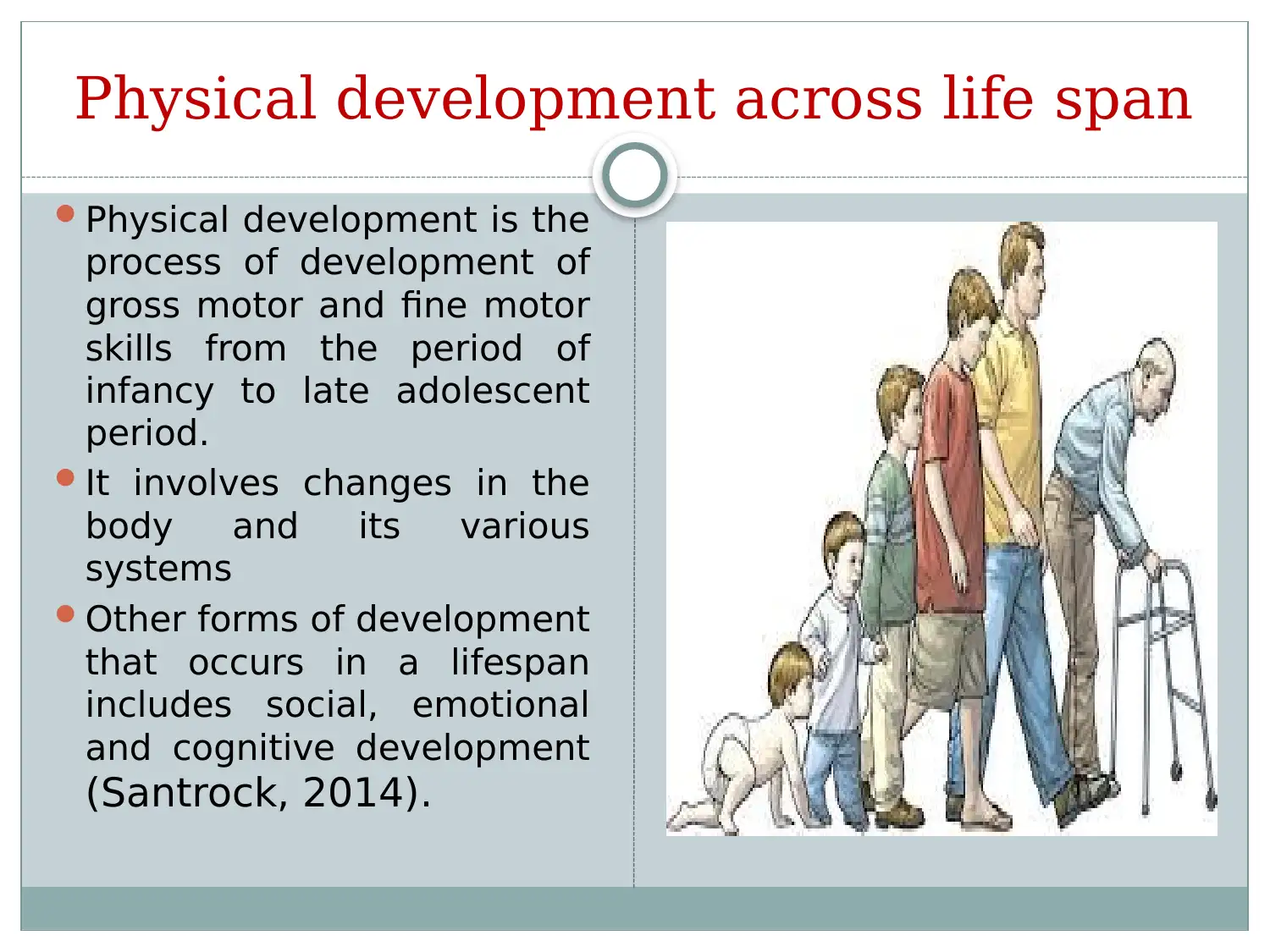
Physical development across life span
Physical development is the
process of development of
gross motor and fine motor
skills from the period of
infancy to late adolescent
period.
It involves changes in the
body and its various
systems
Other forms of development
that occurs in a lifespan
includes social, emotional
and cognitive development
(Santrock, 2014).
Physical development is the
process of development of
gross motor and fine motor
skills from the period of
infancy to late adolescent
period.
It involves changes in the
body and its various
systems
Other forms of development
that occurs in a lifespan
includes social, emotional
and cognitive development
(Santrock, 2014).
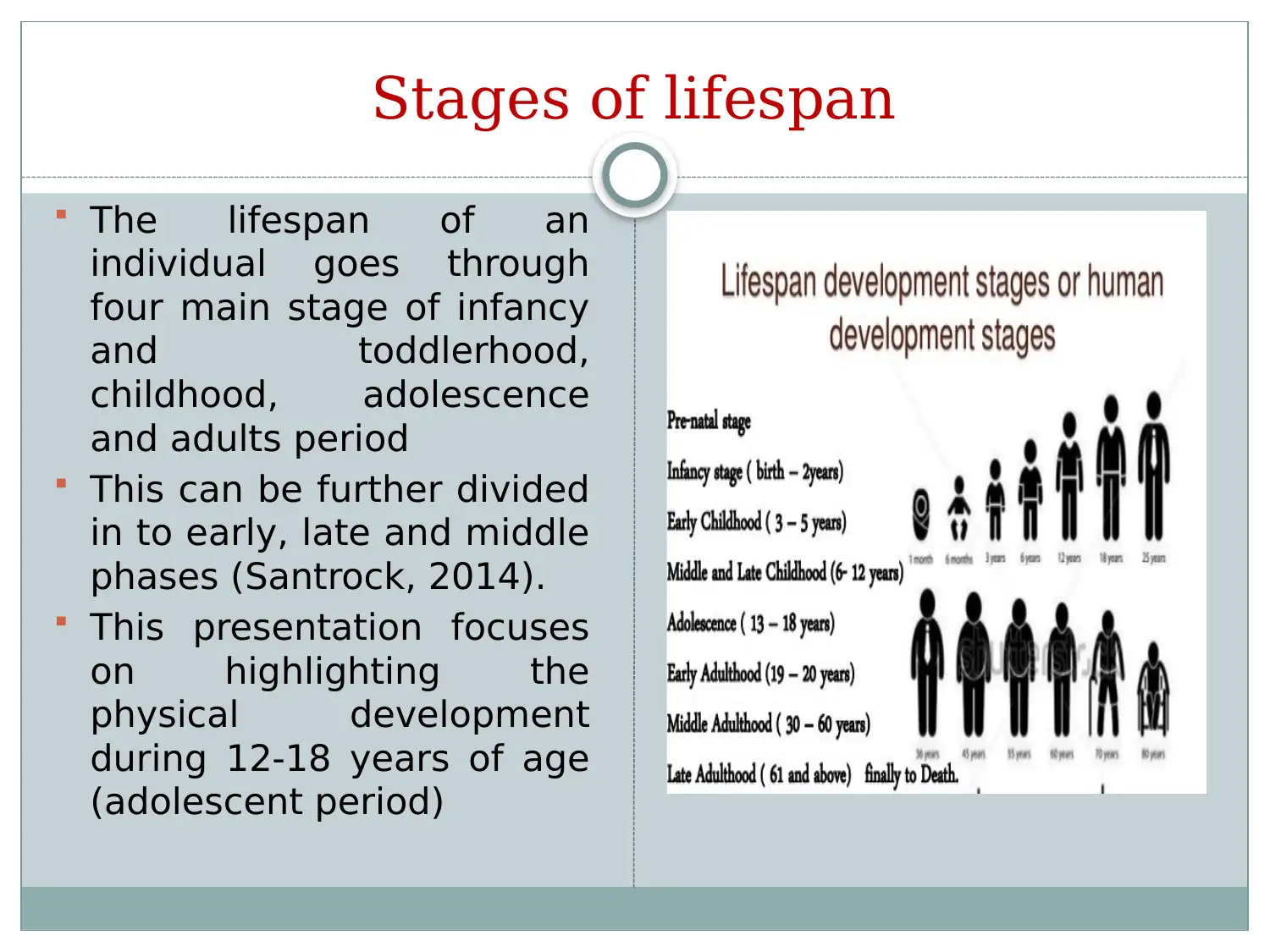
Stages of lifespan
The lifespan of an
individual goes through
four main stage of infancy
and toddlerhood,
childhood, adolescence
and adults period
This can be further divided
in to early, late and middle
phases (Santrock, 2014).
This presentation focuses
on highlighting the
physical development
during 12-18 years of age
(adolescent period)
The lifespan of an
individual goes through
four main stage of infancy
and toddlerhood,
childhood, adolescence
and adults period
This can be further divided
in to early, late and middle
phases (Santrock, 2014).
This presentation focuses
on highlighting the
physical development
during 12-18 years of age
(adolescent period)
⊘ This is a preview!⊘
Do you want full access?
Subscribe today to unlock all pages.

Trusted by 1+ million students worldwide
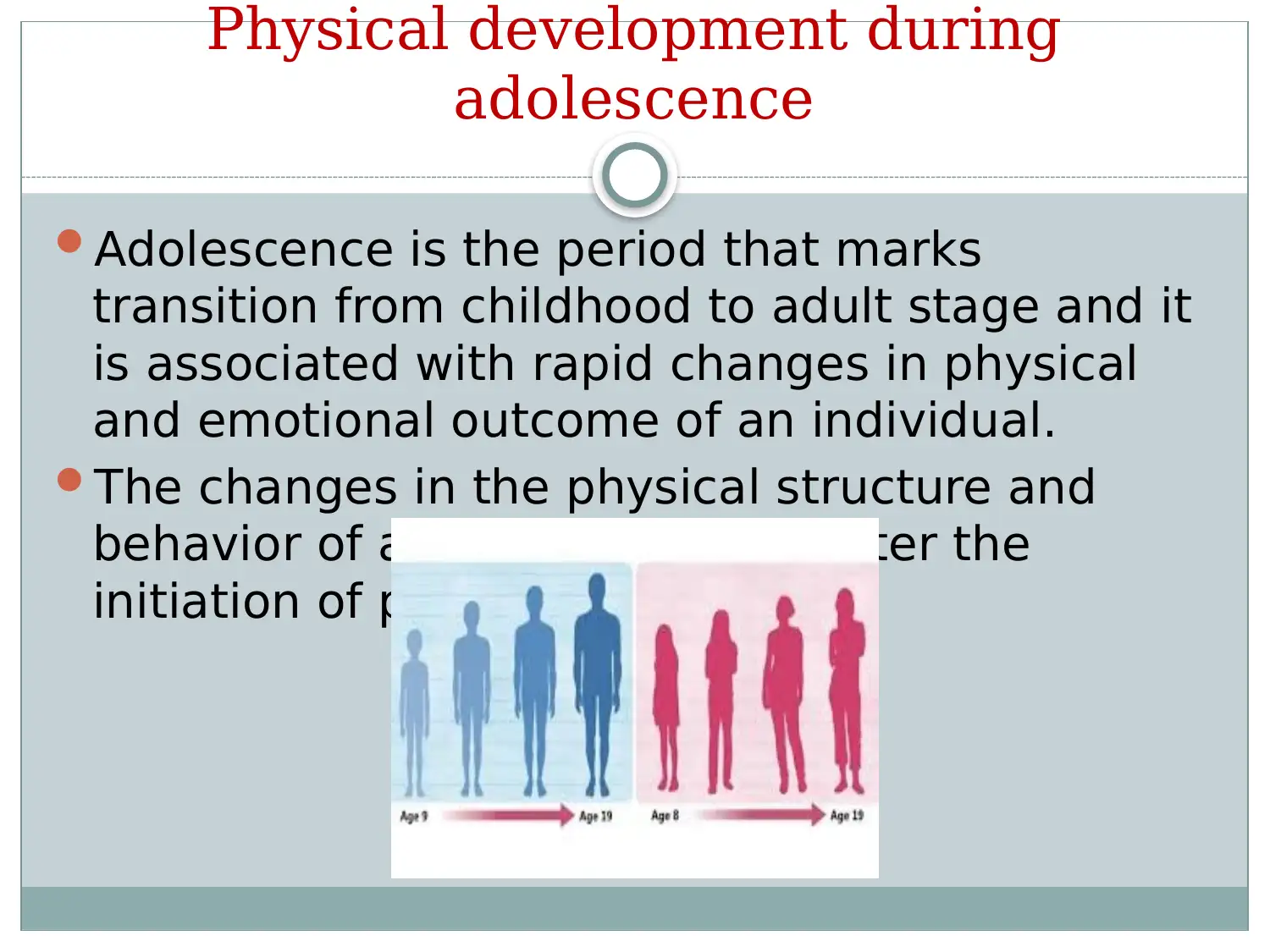
Physical development during
adolescence
Adolescence is the period that marks
transition from childhood to adult stage and it
is associated with rapid changes in physical
and emotional outcome of an individual.
The changes in the physical structure and
behavior of adolescent occurs after the
initiation of puberty.
adolescence
Adolescence is the period that marks
transition from childhood to adult stage and it
is associated with rapid changes in physical
and emotional outcome of an individual.
The changes in the physical structure and
behavior of adolescent occurs after the
initiation of puberty.
Paraphrase This Document
Need a fresh take? Get an instant paraphrase of this document with our AI Paraphraser
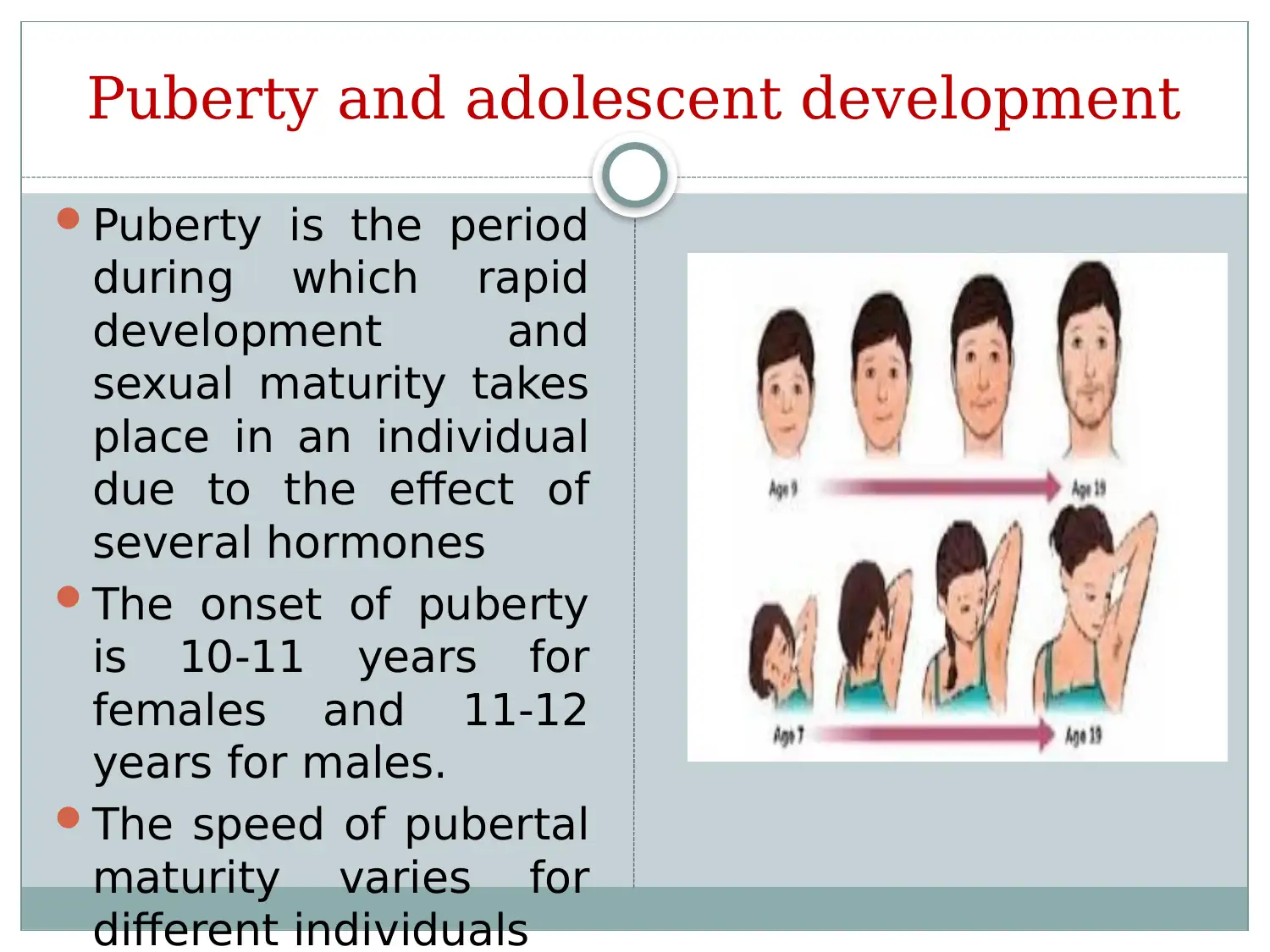
Puberty and adolescent development
Puberty is the period
during which rapid
development and
sexual maturity takes
place in an individual
due to the effect of
several hormones
The onset of puberty
is 10-11 years for
females and 11-12
years for males.
The speed of pubertal
maturity varies for
different individuals
Puberty is the period
during which rapid
development and
sexual maturity takes
place in an individual
due to the effect of
several hormones
The onset of puberty
is 10-11 years for
females and 11-12
years for males.
The speed of pubertal
maturity varies for
different individuals
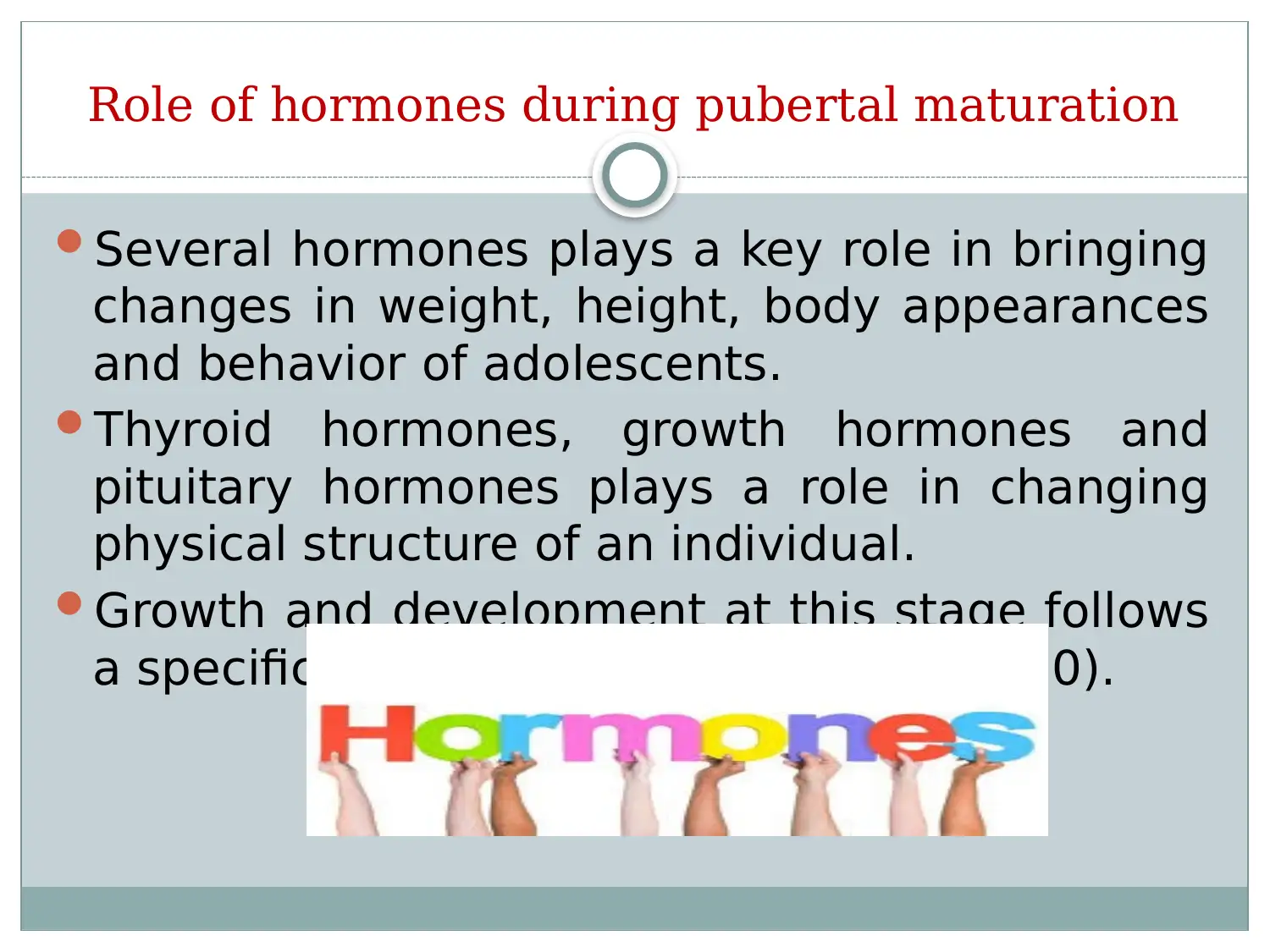
Role of hormones during pubertal maturation
Several hormones plays a key role in bringing
changes in weight, height, body appearances
and behavior of adolescents.
Thyroid hormones, growth hormones and
pituitary hormones plays a role in changing
physical structure of an individual.
Growth and development at this stage follows
a specific sequence (Forbes & Dahl, 2010).
Several hormones plays a key role in bringing
changes in weight, height, body appearances
and behavior of adolescents.
Thyroid hormones, growth hormones and
pituitary hormones plays a role in changing
physical structure of an individual.
Growth and development at this stage follows
a specific sequence (Forbes & Dahl, 2010).
⊘ This is a preview!⊘
Do you want full access?
Subscribe today to unlock all pages.

Trusted by 1+ million students worldwide
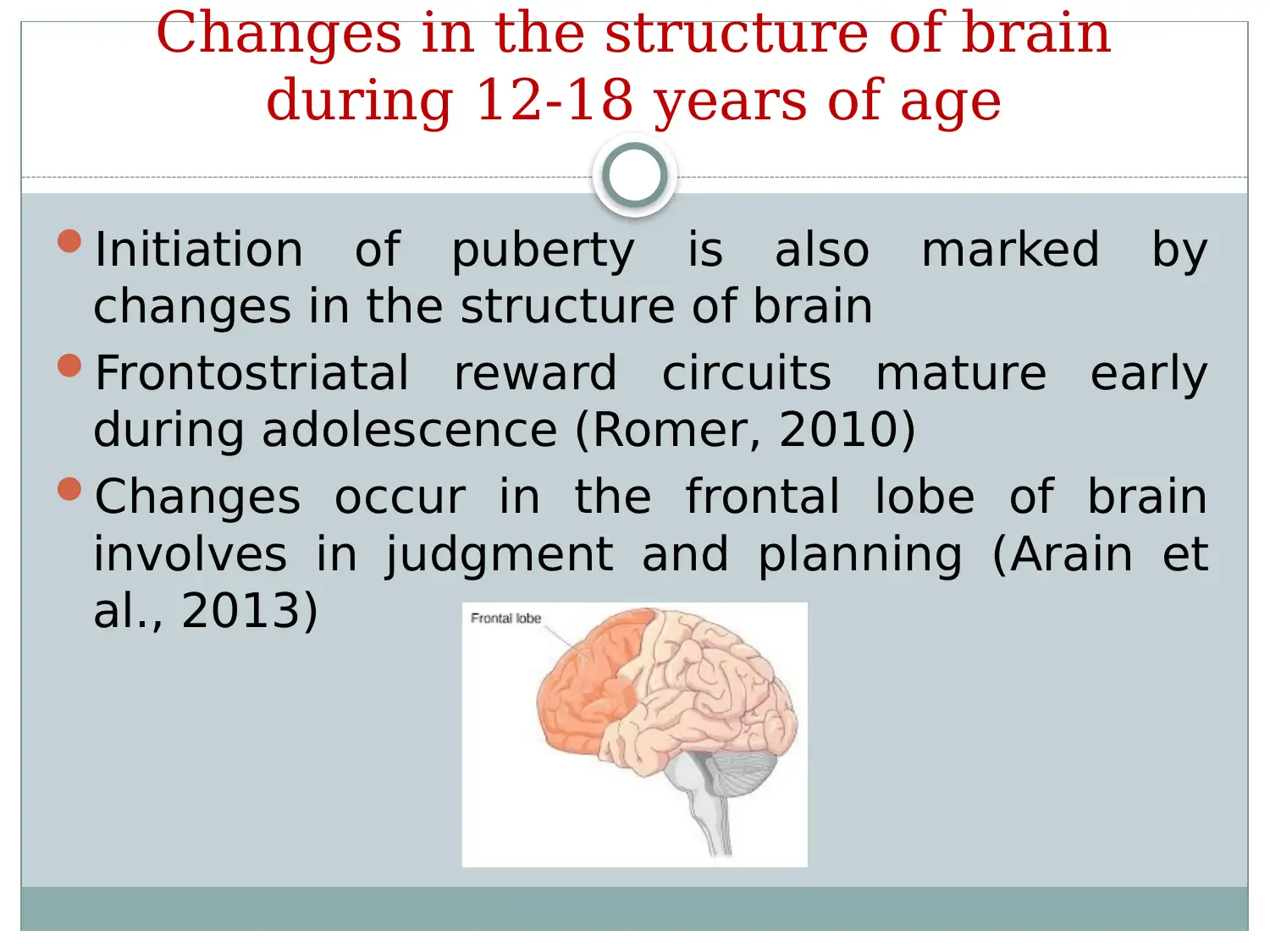
Changes in the structure of brain
during 12-18 years of age
Initiation of puberty is also marked by
changes in the structure of brain
Frontostriatal reward circuits mature early
during adolescence (Romer, 2010)
Changes occur in the frontal lobe of brain
involves in judgment and planning (Arain et
al., 2013)
during 12-18 years of age
Initiation of puberty is also marked by
changes in the structure of brain
Frontostriatal reward circuits mature early
during adolescence (Romer, 2010)
Changes occur in the frontal lobe of brain
involves in judgment and planning (Arain et
al., 2013)
Paraphrase This Document
Need a fresh take? Get an instant paraphrase of this document with our AI Paraphraser
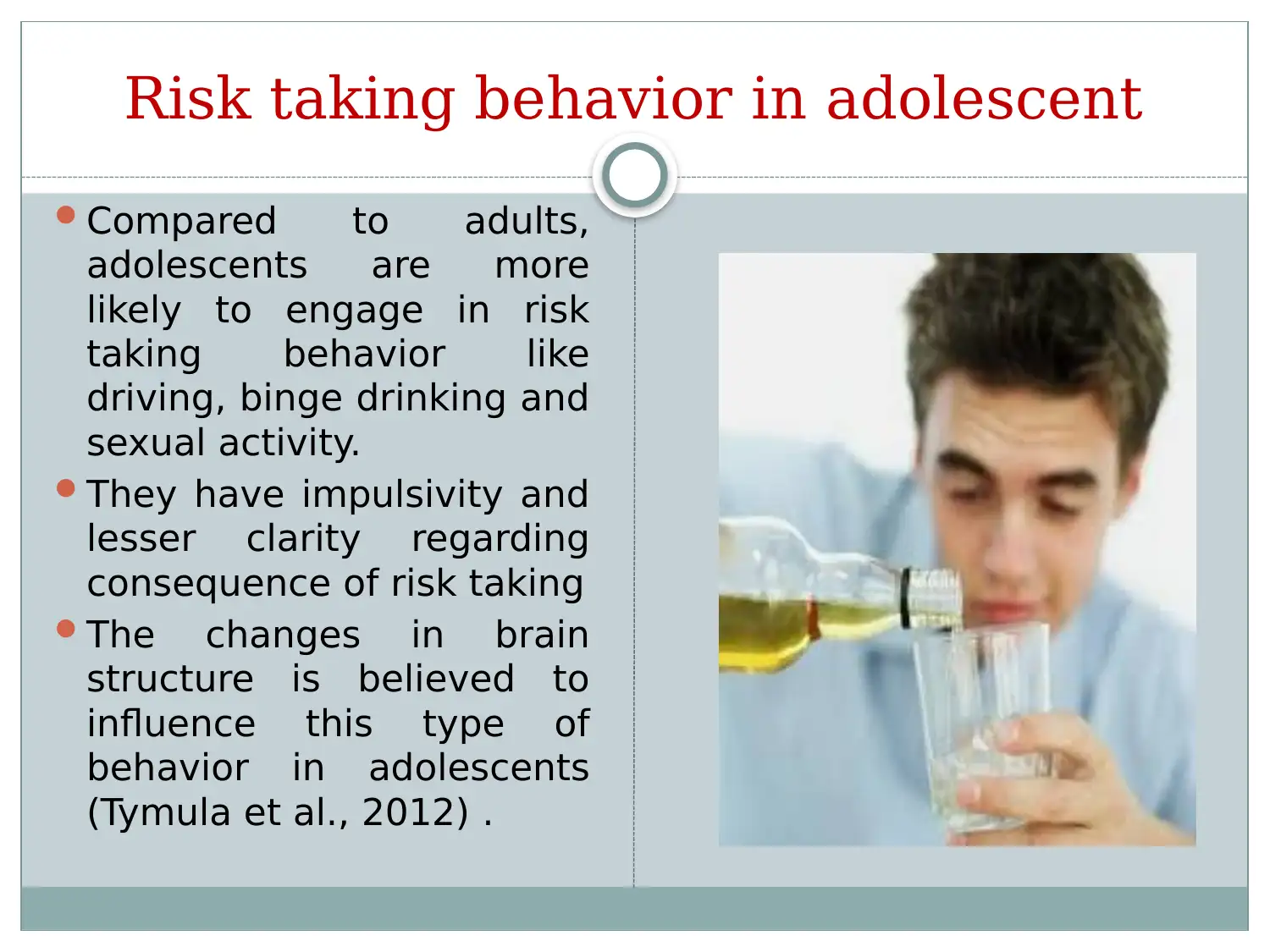
Risk taking behavior in adolescent
Compared to adults,
adolescents are more
likely to engage in risk
taking behavior like
driving, binge drinking and
sexual activity.
They have impulsivity and
lesser clarity regarding
consequence of risk taking
The changes in brain
structure is believed to
influence this type of
behavior in adolescents
(Tymula et al., 2012) .
Compared to adults,
adolescents are more
likely to engage in risk
taking behavior like
driving, binge drinking and
sexual activity.
They have impulsivity and
lesser clarity regarding
consequence of risk taking
The changes in brain
structure is believed to
influence this type of
behavior in adolescents
(Tymula et al., 2012) .
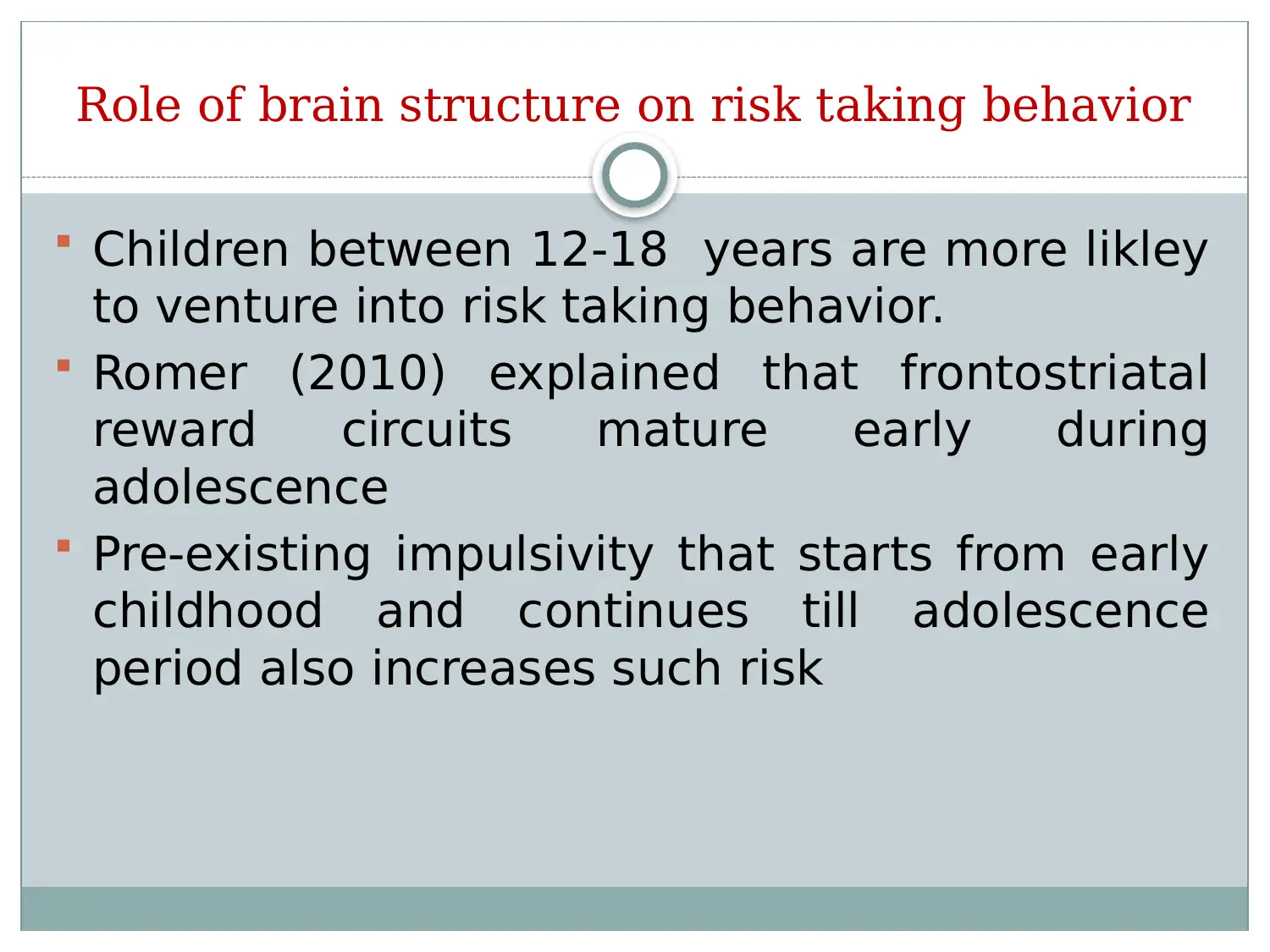
Role of brain structure on risk taking behavior
Children between 12-18 years are more likley
to venture into risk taking behavior.
Romer (2010) explained that frontostriatal
reward circuits mature early during
adolescence
Pre-existing impulsivity that starts from early
childhood and continues till adolescence
period also increases such risk
Children between 12-18 years are more likley
to venture into risk taking behavior.
Romer (2010) explained that frontostriatal
reward circuits mature early during
adolescence
Pre-existing impulsivity that starts from early
childhood and continues till adolescence
period also increases such risk
⊘ This is a preview!⊘
Do you want full access?
Subscribe today to unlock all pages.

Trusted by 1+ million students worldwide
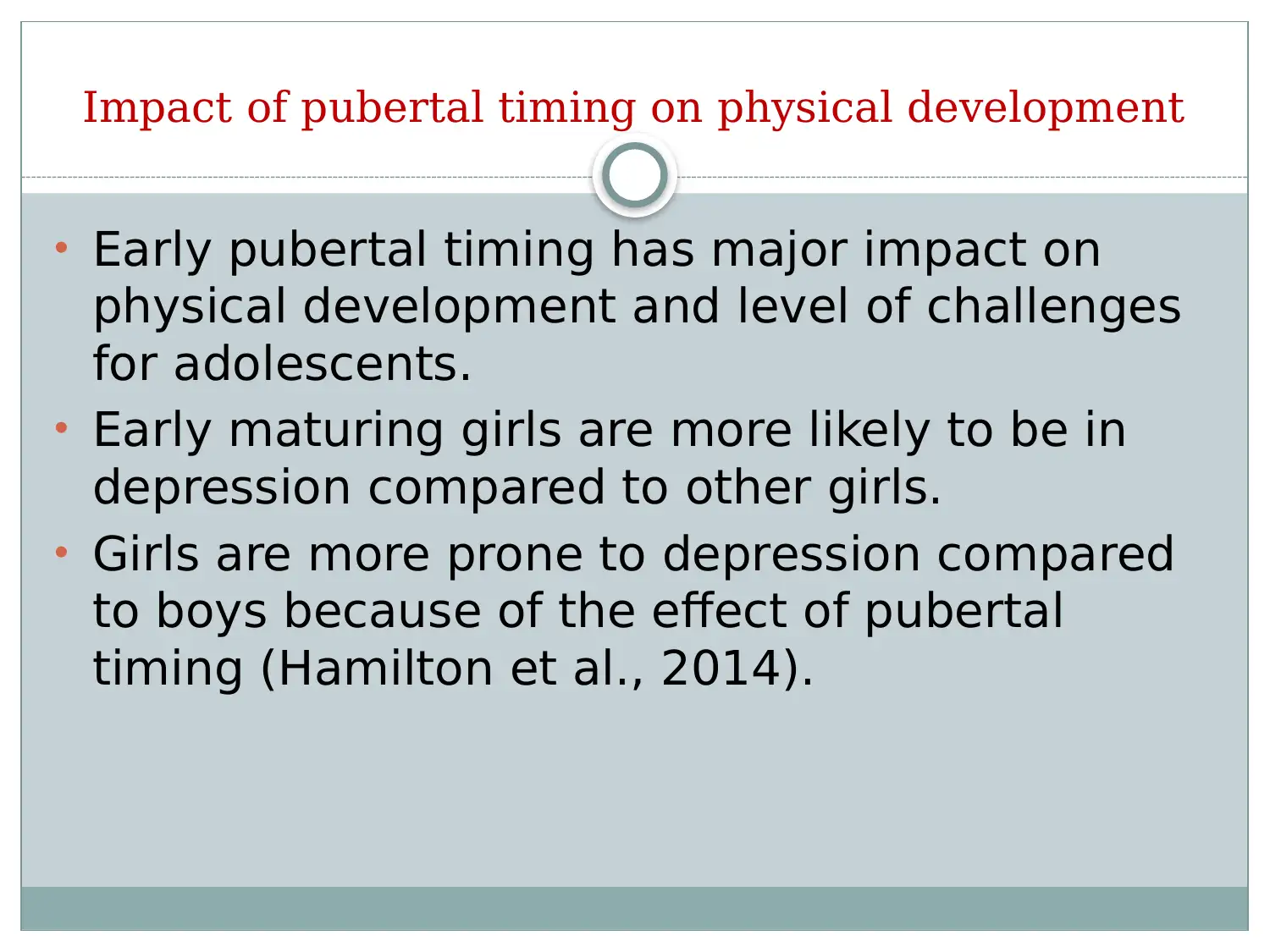
Impact of pubertal timing on physical development
• Early pubertal timing has major impact on
physical development and level of challenges
for adolescents.
• Early maturing girls are more likely to be in
depression compared to other girls.
• Girls are more prone to depression compared
to boys because of the effect of pubertal
timing (Hamilton et al., 2014).
• Early pubertal timing has major impact on
physical development and level of challenges
for adolescents.
• Early maturing girls are more likely to be in
depression compared to other girls.
• Girls are more prone to depression compared
to boys because of the effect of pubertal
timing (Hamilton et al., 2014).
Paraphrase This Document
Need a fresh take? Get an instant paraphrase of this document with our AI Paraphraser
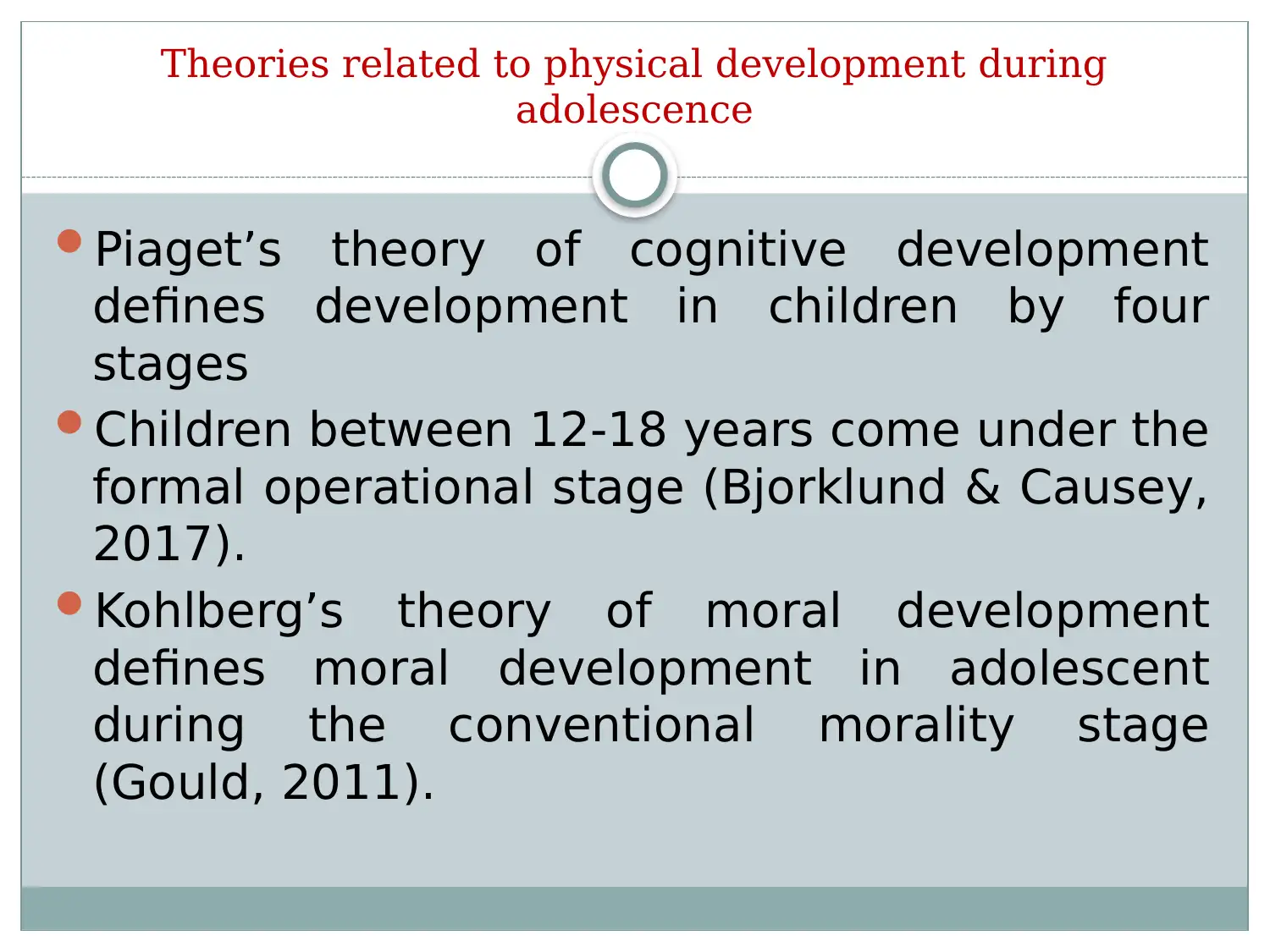
Theories related to physical development during
adolescence
Piaget’s theory of cognitive development
defines development in children by four
stages
Children between 12-18 years come under the
formal operational stage (Bjorklund & Causey,
2017).
Kohlberg’s theory of moral development
defines moral development in adolescent
during the conventional morality stage
(Gould, 2011).
adolescence
Piaget’s theory of cognitive development
defines development in children by four
stages
Children between 12-18 years come under the
formal operational stage (Bjorklund & Causey,
2017).
Kohlberg’s theory of moral development
defines moral development in adolescent
during the conventional morality stage
(Gould, 2011).
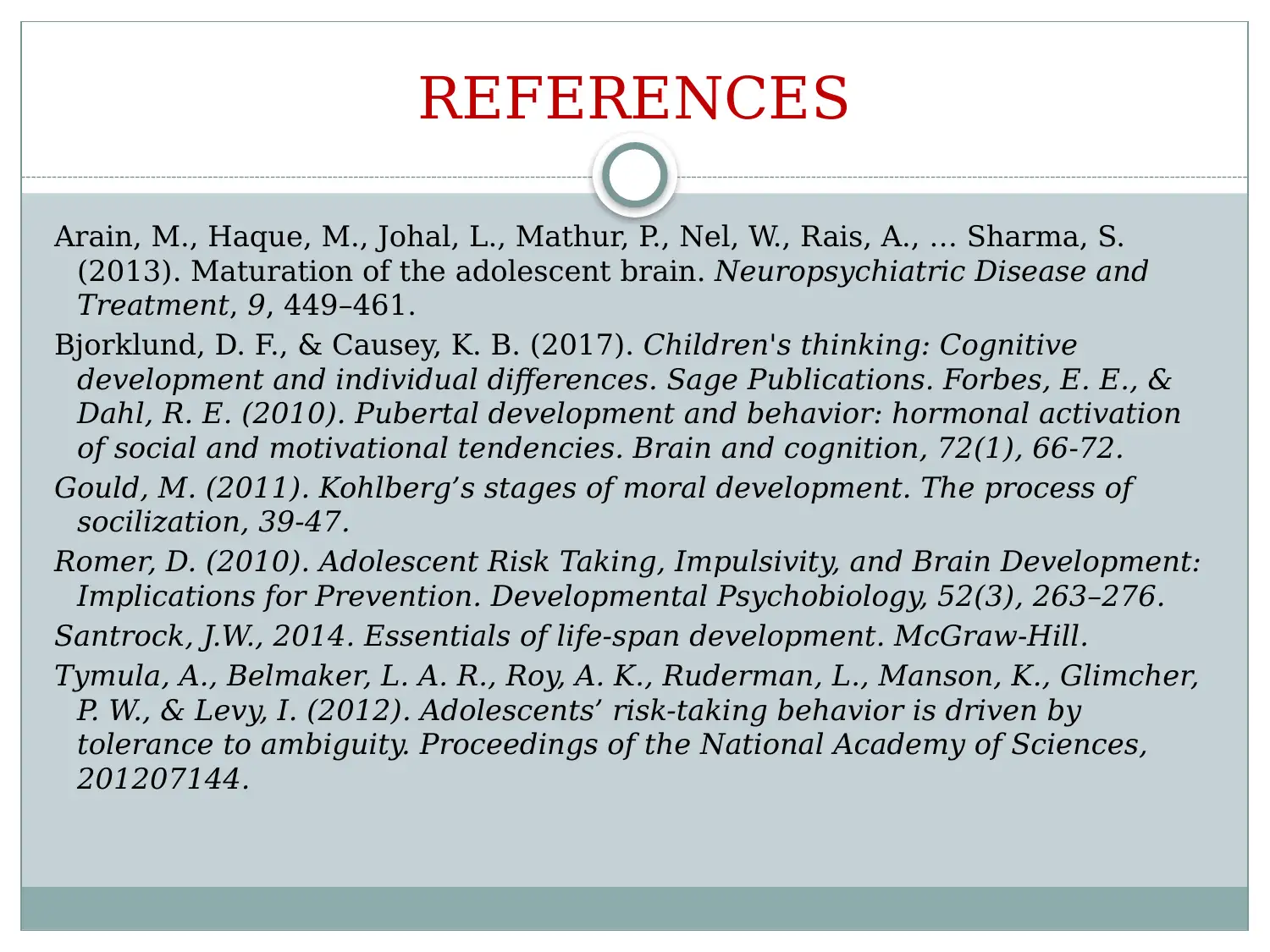
REFERENCES
Arain, M., Haque, M., Johal, L., Mathur, P., Nel, W., Rais, A., … Sharma, S.
(2013). Maturation of the adolescent brain. Neuropsychiatric Disease and
Treatment, 9, 449–461.
Bjorklund, D. F., & Causey, K. B. (2017). Children's thinking: Cognitive
development and individual differences. Sage Publications. Forbes, E. E., &
Dahl, R. E. (2010). Pubertal development and behavior: hormonal activation
of social and motivational tendencies. Brain and cognition, 72(1), 66-72.
Gould, M. (2011). Kohlberg’s stages of moral development. The process of
socilization, 39-47.
Romer, D. (2010). Adolescent Risk Taking, Impulsivity, and Brain Development:
Implications for Prevention. Developmental Psychobiology, 52(3), 263–276.
Santrock, J.W., 2014. Essentials of life-span development. McGraw-Hill.
Tymula, A., Belmaker, L. A. R., Roy, A. K., Ruderman, L., Manson, K., Glimcher,
P. W., & Levy, I. (2012). Adolescents’ risk-taking behavior is driven by
tolerance to ambiguity. Proceedings of the National Academy of Sciences,
201207144.
Arain, M., Haque, M., Johal, L., Mathur, P., Nel, W., Rais, A., … Sharma, S.
(2013). Maturation of the adolescent brain. Neuropsychiatric Disease and
Treatment, 9, 449–461.
Bjorklund, D. F., & Causey, K. B. (2017). Children's thinking: Cognitive
development and individual differences. Sage Publications. Forbes, E. E., &
Dahl, R. E. (2010). Pubertal development and behavior: hormonal activation
of social and motivational tendencies. Brain and cognition, 72(1), 66-72.
Gould, M. (2011). Kohlberg’s stages of moral development. The process of
socilization, 39-47.
Romer, D. (2010). Adolescent Risk Taking, Impulsivity, and Brain Development:
Implications for Prevention. Developmental Psychobiology, 52(3), 263–276.
Santrock, J.W., 2014. Essentials of life-span development. McGraw-Hill.
Tymula, A., Belmaker, L. A. R., Roy, A. K., Ruderman, L., Manson, K., Glimcher,
P. W., & Levy, I. (2012). Adolescents’ risk-taking behavior is driven by
tolerance to ambiguity. Proceedings of the National Academy of Sciences,
201207144.
⊘ This is a preview!⊘
Do you want full access?
Subscribe today to unlock all pages.

Trusted by 1+ million students worldwide
1 out of 13
Related Documents
Your All-in-One AI-Powered Toolkit for Academic Success.
+13062052269
info@desklib.com
Available 24*7 on WhatsApp / Email
![[object Object]](/_next/static/media/star-bottom.7253800d.svg)
Unlock your academic potential
Copyright © 2020–2025 A2Z Services. All Rights Reserved. Developed and managed by ZUCOL.





